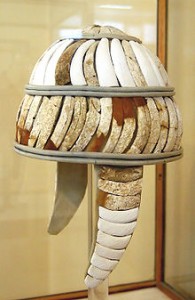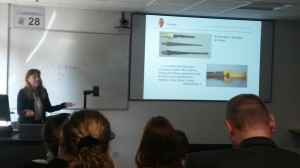Term has begun anew and that means more excellent opportunities to engage with research by some of the world’s leading academics in any and all fields of archaeology. The first research seminar kicked off with a paper by Exeter’s own Dr. Kristin Leith entitled:
“The Shaft Grave Penthesileia: An investigation of Burial 58 Myc and a critique of the use of ‘domaining’ to explain Mycenaean culture”
Kristin elaborated on some of her PhD investigations into gender roles linked with martial equipment in the Aegean Bronze Age and in particular the Mycenaean Shaft Grave B complex. Her focus on Friday was one burial in particular: that of the female called Burial 58 Mycenae. The grave complex, containing 17 burials and a huge wealth of grave goods including swords, daggers, arrows, and a rather spectacular looking boar’s tusk helmet, has long been associated with male warrior identities and presumed to represent the hierarchical nature of society; Kristin’s analysis of the female burials and the associated grave goods addressed the potential flaws in this interpretation.
The particularly fascinating case study of Burial 58 Myc contained a woman buried with two bronze swords, two bronze daggers, two bronze knives, a bronze spearhead, as well as several other burial associations – quite clearly too many weapons for any individual to have used at any one time! Different individuals of different age and sex were associated with certain implements, though swords and daggers were common with all burials. Kristin made the case that warrior identities should thus not be considered a solely male concept; women too could engage with those elements of society traditionally seen in the literature as a sphere reserved for men and divinities. The biological kinship between Burial 58 Myc and nearby skeletons, suggests a potentially more heterarchical society.
It was the weapons that inevitably drew the focus of subsequent discussion (we just can’t resist the chance to talk about stabby implements!) Thoughts and comments were raised regarding the social relationships involved in producing and gifting the artefacts, the potential agency of the individuals involved, while the closing talking points focused on the more logistical aspects of use and manufacture of the implements. A brilliant opening session and I look forward to many more to come this term!
Acknowledgments
Many thanks to Dr. Kristin Leith for presenting such a fascinating talk. For anyone interested in reading more of her research you can visit her Exeter eprofile page here: http://humanities.exeter.ac.uk/archaeology/staff/kleith/
Written by Matt Knight.


